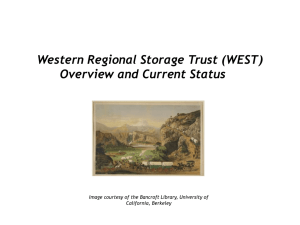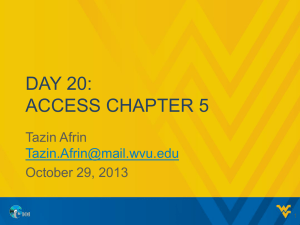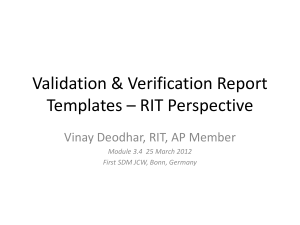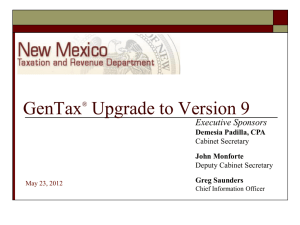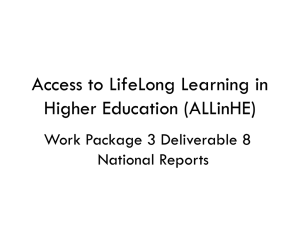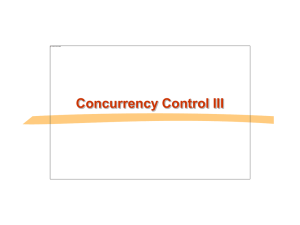Self Review Validation Workshop 2013
advertisement
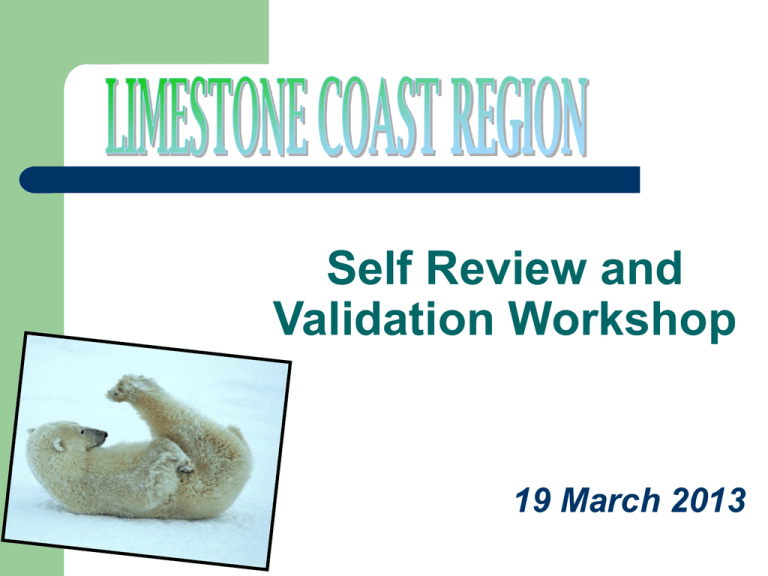
Self Review and Validation Workshop 19 March 2013 The DIAf – Improvement Cycle The DECS Improvement and Accountability framework states that “validation verifies the quality of the self review process, outcomes reported and actions proposed”. Validation is part of an ongoing improvement process and should reflect the information gathered over the 3 years. It brings together your site’s learning and work to achieve STANDARDS, address SELF REVIEW findings, actions from IMPROVEMENT PLANNING, outcomes of INTERVENTION & SUPPORT and provides a PERFORMANCE REPORT on your progress and directions. Purpose of Validation in Schools Validation provides the formal opportunity for: School leaders and their communities to…. Reflect on practices and present their school’s improvement journey from the past three years, and Gain feedback, confirmation and recommendations on future directions Purpose of Validation in Schools Validation provides the formal opportunity for: Regional leaders to…. Support, affirm and challenge a school’s improvement journey (using the DIAf) Apply an external perspective and moderation Support the achievement of agreed standards Principles of Validation in schools Validation: Requires each school to reflect on their learning and improvement based on their ongoing self review processes Requires schools to accept responsibility for presenting their information accurately and frankly Is an open, evidence based process focused on improvement Is an appreciative process, identifying strengths, providing feedback and recommendations Recommendations arise from what is presented during the validation process Validation Processes In our region the Validation process involves: – – – – – A one day on-site visit, (as per the 2012 – 2014 Regional Self Review Validation Schedule) A team including Site Leader, RD/ARD, a Regional Leadership Team Member, a Peer Site Leader (optional) and GC Chairperson (optional) May also include Site Leadership Team members, other staff members A schedule that includes a presentation of data and evidence, discussion and possibly a tour of the school Reference – Limestone Coast Region self Review Position Paper Limestone Coast Self Review Position Paper What stays the same The importance of Self Review Processes and an Improvement Cycle over the past 3 years to inform validation processes A focus on learner outcomes and data analyses The report format including: – – Commendations and Recommendations The section of panel feedback in regards to: the school’s ongoing self-review processes meet the standards outlined in the DIAf guidelines and effective plans and processes are in place to address the findings of self-review Self Review Standards Revisions for 2012-14 Previously we have asked for a scan of the nine DIAf principles of improvement and effectiveness To strengthen the centrality of the DIAf Focus on Learning principle, four key focus areas have been identified: – Quality Teaching and Learning, – Curriculum Coherence, – Learner Outcomes and – Leading Improvement A revised report template Focus on Learning 2012-14 Criteria 2007-11 Criteria Learner Achievement and Wellbeing Curriculum Coherence High expectations for ALL learners Learner Outcomes Shared beliefs and understandings Leading Improvement Plans, processes and practices for T&L Quality Teaching and Learning Focus On Learning strands TASK: Using the strategic level of the Validation rubric – – – Highlight key words Summarise the focus of each sub-strand Where are you up to – current improvement priority, (on your SIP), past improvement priority (achieved/embedded), future priority (yet to cover) Example of task High Expectations Performance Indicators – Quality Teaching and Learning (Strategic level) Most staff have high expectations and these are communicated to students and parents. Opportunities are in place to promote consistency between staff and to moderate standards. Consistent assessment practices as, of and for learning are used by staff to support planning and to identify strategies to assist individuals and groups to work towards or exceed agreed standards. Focus STANDARDS High expectations known by all Staff consistency & moderation of standards All students supported to work towards or exceed agreed standards Current/ Past/ Future Improvement Priority Focus on Learning Changes reflect: – – – – Recent school improvement research Strengthened focus on OUTCOMES Alignment with Australian Curriculum Language and concepts of TfEL and the Literacy Secretariat e.g. whole school approach, learning design, explicit and systematic – Role of the leader in establishing the environment and conditions for learning Self Review Validation Preparation Program for the day Scaffold for Self Review Validation – – – – DIAf Validation Rubrics Data/Evidence Where to from here Resources and support PREPARATION Prior to the Validation Day Negotiate the date with your director and other team members Identify your validation panel / team – – Including Site Leader, RD/ARD, and a Regional Leadership Team Member May also include Site Leadership Team members, other staff members &/or Peer Site Leader Send your director two page summary of your Self Review, including site context, two weeks prior to Validation – template available on LC website Self Review Summary (2 pages) Possible Validation Day Program When Activity Who 8.45am – 9.00am Validation Team meeting with Principal & Validation Team Leadership Team – to discuss program for the day 9.00 – 11.00am Presentation Tour of school, (optional) Principal &/ Leadership Team 11.00am – 11.20am RECESS with staff All 11.20am – 12.50pm Meetings with / presentations by: Validation Team Student Focus Groups Parent focus group Staff group 12.50pm – 1.20pm LUNCH Validation Team 1.20pm – 2.45pm Share data and information Draw conclusions and document Validation Team 2.45pm – 3.30pm Share outcomes with Leadership Team Validation Team 3.30pm – 4.00pm Share commendations & recommendations with staff (& Governing Council?) Validation Team THE VALIDATION DAY Useful documents to have available … Site Improvement Plan Annual Reports – or summary of past three years Operational Plans/Management Plans Action Plans Parent, Staff and Student Surveys Documented Policies and Processes Site Data Overview Level 2 scans of DIAf principles Scaffolding Self Review Validation Process Limestone Coast Region Examples of Standards: Self Review and Validation 2012 - 2014 DECD English Standard: Students from Year 1 to Year 10 achieve an A,B or C against the Australian Curriculum Students achieve an A,B or C in English or recognised literacy course at SACE Stage 1 or 2 To whom, and how, do we report improvements and progress towards the achievement of standards and/or targets How is the plan implemented and monitored ? • Data schedule • Staff meeting/Student Free days schedule • Who is responsible? • Ongoing self review? What processes are in place to ensure all learners achieve successful outcomes? • Intervention and Support processes – Wave 1,2 and 3 Regional Reading Standard: Students’ reading ages should match chronological ages When is the Self Review held? Who is involved in the review? Describe the process used. Improvement priorities decided as a result of the Self Review (and with reference to the region’s improvement priorities) • Present and discuss Site Improvement Plan including priorities, SMARTA targets, strategies and evaluation measures, (see LC Site Improvement Plan position paper for more information) Data/Evidence: (Use multiple measures of data) • Perception Data • Process Data • Demographic Data • Learner Achievement Data Multiple Measures of Data • Demographic • Perception • Learner Achievement • Processes * Recommendations from previous self review validation, SSI diagnostic review, (if applicable) Warning: Avoid Death by Data As a site you need to identify the key data sets that enable you to best reflect your site and progress made over time in the quality of teaching and learning The data sets suggested are POSSIBLE data sets for you to consider As a site it is best for your staff to collaboratively identify which data sets best support you to monitor progress Improvement - Evidence Focus on Learning Rubric Suggested approach Use the Focus On Learning rubric as a guide to describe improvements/changes that have occurred For example - development of a whole school literacy agreement (improvement strategy in SIP) What has this meant for teachers and what has it meant for students What evidence do you have that supports the improvement or change to teacher/student learning Where to Next? FOLLOW-UP Following the Validation Day Regional Office will send draft Validation Report to all team / panel members Once agreed, two copies of the report will be sent to sites for signing – RD/ARD, Site Leader & Governing Council Chair, (an electronic version of the final report will also be emailed to site leaders) Resources and Support Self Review Folder – Four steps to self review – Level 2 and 3 tools from QIE – Rubrics for each of the principles including the Validation FOCUS ON LEARNING rubric QIE website www.decs.sa.gov.au/quality – The Full Self Review Guide Limestone Coast website Support for Sites – workshops & website
